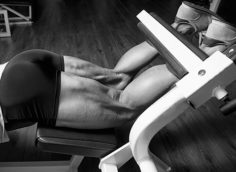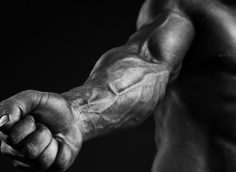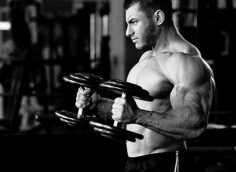Rows Don't Work If You Do Them Wrong
For upper back strength and size, nothing beats rowing exercises. Sadly, most lifters do rows with crappy technique and body mechanics, eliminating the benefits. Here are several unique rowing variations that not only crush your back (in a good way), but also eliminate form issues by forcing you to use proper mechanics.
This exercise teaches you how to dial in your horizontal pulling technique. Any faulty mechanics, movement dysfunction, or flawed activation patterns will cause you to lose your balance. To do it, you'll have to make continuous adjustments and technique corrections until every component of body mechanics, from head to toe, is honed in.
Anything less than perfection will result in loss of body control and inability to perform the movement. It provides you with enough sensory feedback and internal cuing to gradually self-correct and auto-regulate body positioning. As a result, the quadruped row addresses numerous form issues:
- Eliminates over-rowing and excessive range of motion in the contracted position.
- Eliminates overstretching and excessive protraction in the bottom position.
- Reduces excessive momentum and "top rock."
- Eliminates low back compensation and excessive lumbar extension.
- Improves 3D glenohumeral joint mechanics by promoting optimal depression, retraction, and medial rotation of the scapula.
- Reinforces proper elbow tuck and optimal arm mechanics.
- Increases core activation.
- Eliminates cervical compensation patterns in the neck and head.
- Improves full body tension and spinal rigidity.
- Eliminates excessive body rotation common with single-arm rows.
- Prevents and eliminates spinal flexion.
- Promotes proper grip mechanics by producing optimal stacking of the shoulder, elbow, wrist, and hand.
- Teaches strong muscle-mind connection with the lats.
- Produces larger range of motion than most free-weight rows due to the rigid parallel torso position.
- Improves low back health and back pain.
Just before you do any row that involves a bent-over position, have a training partner place a plate or two on your middle upper back. Then have at it. It sounds and looks sadistic and masochistic, but there are multiple benefits:
- Improved form because the back must maintain a natural arch for the plate to sit on. Spinal flexion is impossible.
- Eliminates top rock and excessive momentum. Otherwise, the plates will literally fall off the back and injure animals or small children.
- Increased proprioceptive feedback from lats, middle, and upper back. The plates against your body provide sensory palpation, giving you better kinesthetic awareness of your back activation and postural alignment.
- Helps maintain a steep, near parallel, bent-over position.
- Greater direct overload to the entire posterior chain, including upper back, low back, glutes, and hams, without further fatigue to the arms and grip. As a result, your back muscles are more likely to fail before your arms.
- Keeps you from over-rowing with excessive range of motion because the elbows and shoulder blades will run into the plates, causing them to move around on the back.
- Improves low back strength immensely. The movement represents a combination Romanian deadlift and good-morning in terms of weight distribution with direct tension to the erector muscles.
Many lifters perform bent-over rows incorrectly. One of the most common issues is lack of scapular depression throughout the movement. If the shoulders aren't depressed, then the lats won't receive thorough activation, regardless of how much retraction you create.
In addition, lack of scapular depression on barbell rows causes the elbow to flare, which eventually causes shoulder inflammation and faulty glenohumeral joint mechanics. Rows are meant to improve shoulder mechanics, not degrade them, but the benefits depend on mechanics and form.
Performing rows with horizontal band resistance addresses this and provides some unique benefits:
- It forces you to retract and fully depress the scapula in order to resist the force vectors created from the band as well as to maintain balance.
- It requires greater postural control and spinal positioning. Any spinal flexion will result in the weight pulling your body out of position and losing balance.
- It forces the lats to work overtime. There are two force vectors working against your lat muscles, one that wants to protract them (the barbell load), and one that wants to elevate them (the band resistance). You'll feel like you're performing a combination row and pulldown motion, which is a potent combo for upper back growth.
Doing rows on a back extension or glute ham raise station will crush the entire posterior chain.
In addition, it's nearly impossible to use excessive range of motion on the pulling mechanics because the steep angle keeps the elbows from drifting too high at the top, preventing faulty shoulder mechanics. If you want to make the movement even more taxing, try using a GHR (glute ham raise) unit with a slight decline by having the feet elevated several inches above the hips.
This makes the exercise more taxing on the lats and it eliminates the ability to cheat. This forces you to use very strict form since the upper torso can't move beyond parallel to the floor. The decline also allows for a greater stretch of the lats at the bottom of the movement, which helps produce greater force output and lat activation once you begin each concentric or lifting phase.
A common problem with bent-over rows: the weight is loaded to the front of the body which places greater stress on the low back and also promotes shoulder elevation. Trying to eliminate this by using dumbbells and pulling them to the sides of the body is problematic because the weights run into the legs.
A simple solution? Single-leg bent-over dumbbell rows. Once you learn to balance on one leg, the movement feels more natural than most bent-over rows because the weight can fall to the side of the support leg without being encumbered or crowded.
You'll also be forced to eliminate any momentum, cheating, or technique issues. Any aberrations in form will immediately disrupt balance. Ideally you should be able to handle at least 70% of the weight you use for standard bent-over rows. If you're unable to do this, then you need to work on your single-leg balance, hip function, and rowing mechanics.
Over-rowing by using excessive range of motion in the contracted position is one of the more common mistakes with horizontal pulling movements. It can be difficult to correct, even with proper cuing.
The supine floor row is the perfect exercise for eliminating this issue. The movement will force you to terminate the pulling motion at the optimal end range of motion because the triceps and upper arm will literally run into the floor.
In addition, you'll be forced to retract and depress your shoulder blades as well as pull your entire body into the floor, which improves postural alignment and shoulder mechanics. This can be done using bands or cables. You can do single or double-arm variations. Stronger lifters may have to anchor themselves to the floor with a weight plate or vest.
However, the single-arm version will allow even the most advanced lifter to use ample load without being elevated off the floor. The unilateral variation is also one of the most effective combination horizontal pulling and anti-rotation movements you can do. It nails the upper back and rotary stability muscles of the core.

Few training strategies are as effective for improving body mechanics and proprioceptive feedback as the Hanging Band Technique (HBT) where you use bands to hang weights off the end of the bar.
You'll be forced to use a lighter loads, but the smooth reps, combined with constant tension, reduced momentum, and incredible intramuscular tension results in an enormous pump to the lats and upper back.


Grip activation and forearm mechanics have a big impact on scapular stability and shoulder centration. Intensely activating the muscles around the fingers, hands, and forearms automatically helps centrate and lock the glenohumeral joint into its ideal position. Finger-pinching rows quickly clean up horizontal pulling mechanics.
Although you can produce a similar response from fat grips, using bumper plates and hex-style dumbbells are more effective because even the slightest deviation in shoulder positioning will cause the weight to slide out of the hands.
Finger-pinch movements also force you to perform smooth rowing motions with reduced momentum and optimal range of motion. In addition, any overstretching with over-protraction in the stretched position is punished immediately – the weights will slip out of your fingers.
Although you won't necessarily be able to overload the lats, the neuromuscular efficiency produced, accompanied with the extreme improvements in grip and hand strength, are noteworthy. You'll be able to handle heavier weight with stricter form when you go back to basic rowing movements.





